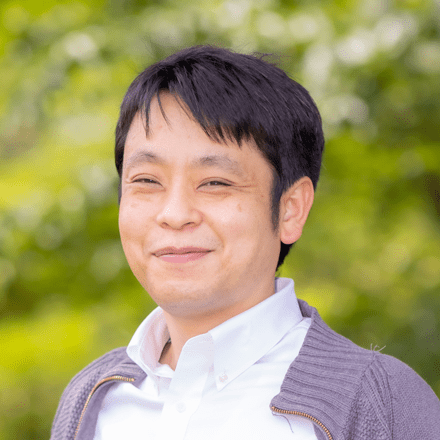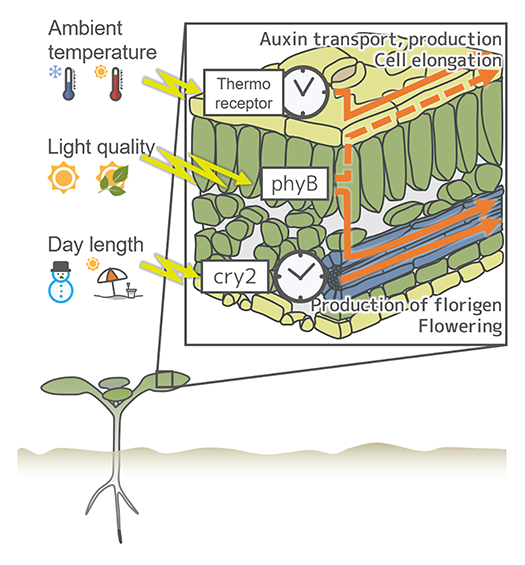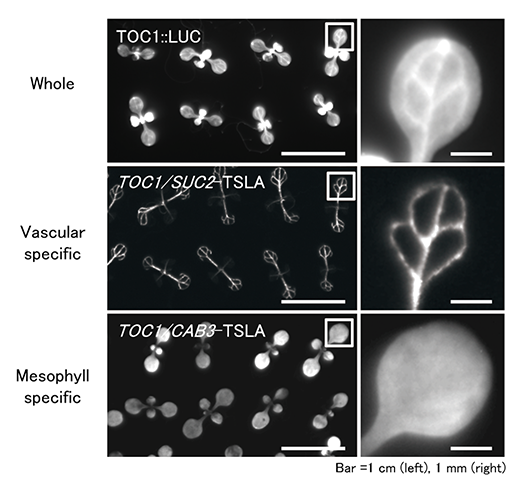Plant Physiology

- Professor
- ENDO Motomu

- Assistant Professor
- KUBOTA Akane

- TAKAHASHI Nozomu

- Labs HP
- https://bsw3.naist.jp/endo/
Outline of Research and Education
Circadian clocks are molecular mechanisms used by plants and other organisms to predict and respond to environmental changes. Approximate 24 hour circadian rhythms affect many aspects of plant physiology, including cell elongation and photoperiodic flowering. To pinpoint how clocks function individual cells and tissues levels, we develop new methods for analysing gene expression with high spatiotemporal resolution. This is accompanied by the application of these to the control of photoperiodic flowering. Through this research, we seek a better understanding of plant physiology and development. We also attempt to identify gaps in our current understanding which can be addressed with greater precision.
Major Research Topics
Dissection of circadian clock functions on an organ, tissue and cellular level
Circadian clocks are used to predict the timing of transitions between day and night, and different seasons. In plants, the circadian clock modulates cell elongation, leaf movement, and flowering. We have shown that these responses can be explained by tissue-specific functions of circadian clocks.
To explore the tissue and cell-type-specific functions of circadian clocks in further detail, we are investigating circadian rhythms with high spatiotemporal resolution and reveal signalling mechanisms with clear biological significance.
Understanding and control of photoperiodic flowering via the circadian clock
Photoperiodic control of flowering is a regulatory mechanism of key physiological importance mediated by the circadian clock. The molecular mechanisms by which the flowering hormone, florigen, regulates flowering have been intensively studied, but there are still questions to be answered regarding the integration of environmental signals into the circadian clock, and how seasonal information is extracted from circadian rhythms. We are assessing how light, temperature, nutrients and other external factors regulate photoperiodic flowering through circadian rhythms; while also applying this knowledge to control crop flowering time without genetic modification.
New technologies for high spatiotemporal analysis
To achieve high spatiotemporal analysis, we are developing new methods to precisely examine the function of the circadian clock. These include specific tissue/cell isolation, non-invasive measurement of tissue-specific gene expression, and an algorithm for a time-series single cell transcriptome. These new approaches provide novel ways to test our current understanding.



References
- Chen WW*, Takahashi N* et al. Nature Plants 6, 416-426, 2020
- Haraguchi K, Torii T, Endo M. Discrete Applied Mathematics 287, 40-52, 2020
- Torii K, Kubota A, Araki T, Endo M. Plant Cell Physiol. 61, 243-254, 2020
- Endo M, et al. Plant Cell Physiol. 59, 1621-1629, 2018
- Song YH*, Kubota A* et al. Nature plants 4, 824-835, 2018
- Endo M, Shimizu H, Araki T Nature Protocols. 11, 1388-1395, 2016
- Shimizu H et al., Nat Plants., 1, 15163, 2015

 NAIST Edge BIO
NAIST Edge BIO